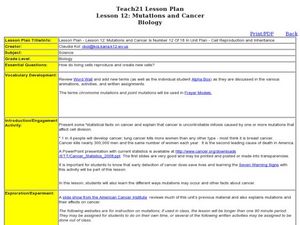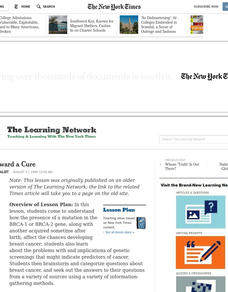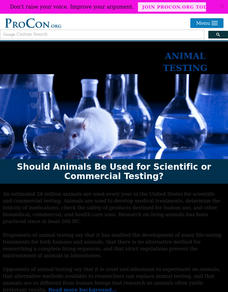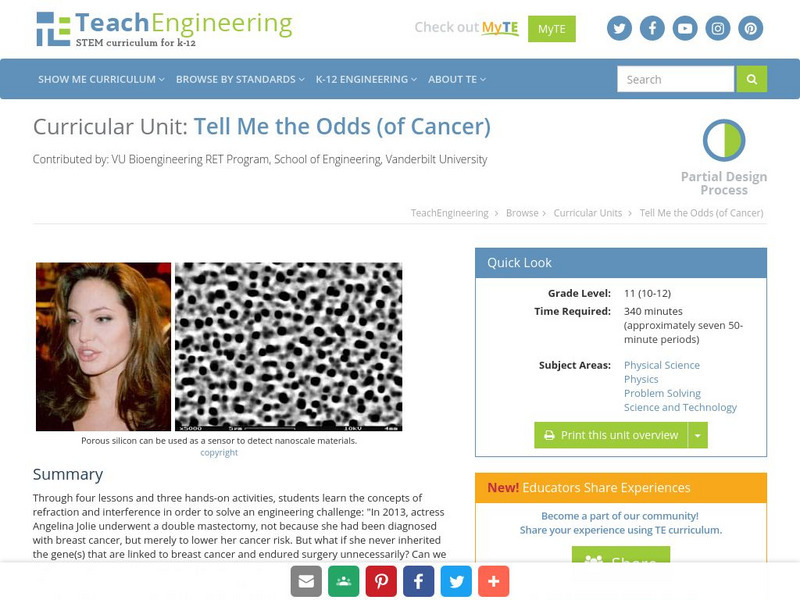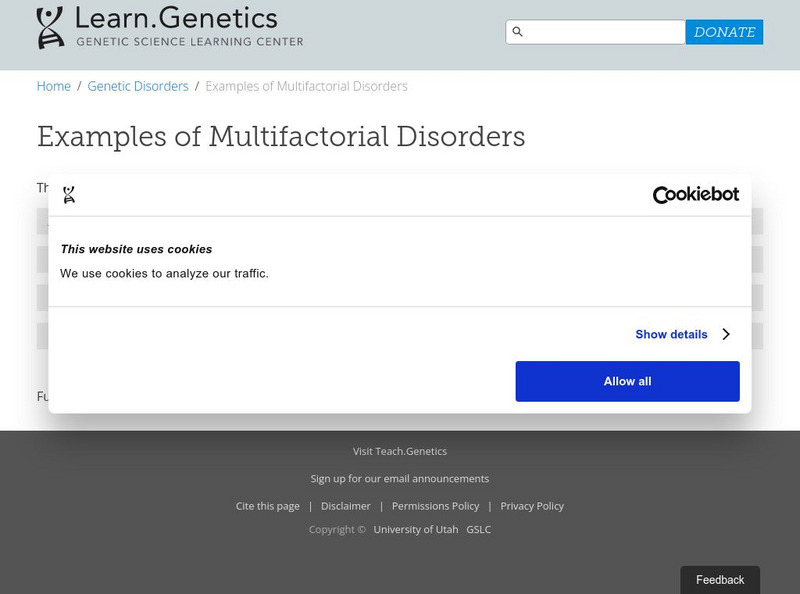National Center for Case Study Teaching in Science
Breast Cancer Risk
How does one determine whether or not someone is at risk for breast cancer? Find out through a comprehensive case study involving two readings and a group activity in which learners assess four women's potential for acquiring the...
Curated OER
Mutations and Cancer
High schoolers study how cancer cells mutate and affect cell division. In this investigative lesson students view a PowerPoint presentation learn the seven warning signs of cancer.
Curated OER
Risk Factor Roulette
Students examine "multiple chemical sensitivity" and how it relates to genetic variation and environmental factors. They read an article, conduct research, and identify risk factors related to chemical sensitivity, asthma, breast cancer,...
Curated OER
Race Toward a Cure
Learners come to explain how the presence of a mutation in the BRCA-1 or BRCA-2 gene, along with another acquired sometime after birth, affect the chances developing breast cancer.
Curated OER
Genetic Testing for Disease Susceptibility
Students explore how testing for particular genetic variations can help people to make decisions in lifestyle and health care choices. They analyze a Web-based case study, participate in class discussion, view video segments and...
Curated OER
Ghost in Your Genes
High schoolers explore DNA microarrays. In this genetics lesson, students model DNA microarrays that are used by scientists. High schoolers work to determine levels of breast cancer genes in patients. They will determine the treatment...
Curated OER
Cells and Cancer
Students idenitfy that cancer is a growth of mutated cells and that cancer cells are only one type of cell that causes disease in our body. They also identify that all eukaryotic cells contain a nucleus, cytoskeleton, and a cell...
Curated OER
The Value of Genetic History
Students explore their genetic background. They assemble their own pedigrees using star patterns for each family member and identifying various dominant traits. Predictions are made for future offspring.
Curated OER
The Value of Genetic History
Students research and assemble their own pedigrees using star patterns for each family member and coloring in various dominant traits. They arrange these patterns on long strips of paper making large, colorful family pedigrees.
Curated OER
Geneticist for a Day
Students discuss and compose a document discussing the transmission of the Huntington's gene- dominant or recessive, sex linked, etc. Additionally, they ought to consider Dr. Wexler's own odds for contracting the disease.
Curated OER
Animal Testing
Animal testing: cruel and inhumane, or innovative and life-saving? Scholars explore the topic and form their own opinions with help from the highly informative website. Pupils read a comprehensive overview of the topic, including...
PBS
Pbs Learning Media: Genetic Therapy and Breast Tumors
This video segment from the Secret of Life School Video: "On the Brink: Portraits of Modern Science" explores the genetics of breast cancer. [3:40]
PBS
Pbs Learning Media: How Cancer Cells Grow and Divide
This animation from NOVA: "Battle in the War on Cancer: Breast Cancer" describes how oncogenes cause cancer and how cancerous cells can spread throughout the body.
Texas Instruments
Texas Instruments: Science Today Breast Cancer Risks
The USA TODAY Snapshot? "Breast cancer risks" shows the percentage of women in several age categories that, statistically, develop breast cancer. Students will notice that the percentages increase as women get older. In this activity,...
TeachEngineering
Teach Engineering: Tell Me the Odds (Of Cancer)
A seven-lesson unit where students learn the concepts of refraction and interference in order to solve this engineering challenge: In 2013, actress Angelina Jolie underwent a double mastectomy, not because she had been diagnosed with...
TeachEngineering
Teach Engineering: Tell Me Doc, Will I Get Cancer?
Students are introduced to the challenge called, Tell Me the Odds, discovering a new way to assess a person's risk of breast cancer. Solving this challenge requires knowledge of refraction and the properties of light.
University of Utah
University of Utah: Genetic Science Learning Center: Examples of Multifactorial Disorders
Use this drop-down menu to explore genetic conditions that involve variations in multiple genes, often coupled with environmental causes (multifactorial disorders). Examples of disorders include breast and ovarian cancer, colon cancer,...
Biotechnology Institute
Biotechnology Institute: Your World: Cracking the Code of Life [Pdf]
The Biotechnology Institute, in conjunction with a special titled, "Cracking the Code of Life" from NOVA/WGBH television, presents this issue dedicated to explorations of the human genome, one of the most exciting and provocative areas...

